Motion Near the EM Spectrum
Between the positive and negative dimensions we find the electromagnetic (EM) spectrum with its eletromagnetic vortices. On each location where the sequence passes the EM spectrum we find one vortex. This vortex is not located entirely on the EM spectrum location, instead it crosses the EM spectrum. At one side of the EM spectrum lies one half of a dimension level, and on the other half of the EM spectrum lies the other half of the dimension level. So too is the vortex divided into two halves, one at each side of the EM spectrum. The vortex looks very different on both these halves. On the EM spectrum itself lies a third division of the vortex, which is just a small fraction of the vortex. Here too the shape looks different. These three parts are considered to be three different vortices. The middle one of these, the vortex that is located exactly on the EM spectrum, is called the intermediate vortex. It is a vortex that does not belong to any of both sides of the EM spectrum.
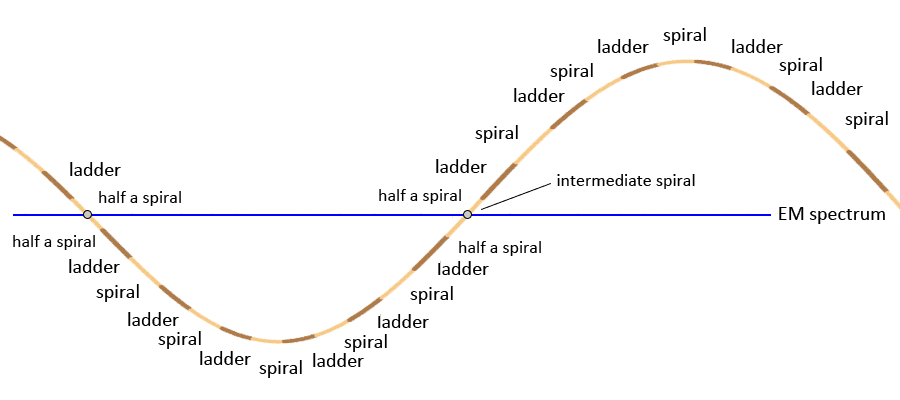
So far there are two known EM crossing locations, the zero point and the infinity ring. Both these EM crossings are locations in the sequence where movement does not have any volume. The zero point is a point without volume and the infinity ring is a circle line without volume. It it logical to assume that the same holds true for all the EM crossing locations at any cycle in the transformation sequence. Like it was already said on the previous page, EM crossings are locations where vortices do not have volume, and all other locations on the EM spectrum line (line is actually a plane) are also locations where vortices do not have volume.
On both the zero point and the infinity ring lies a vortex classified as a spiral, yet both do not look like spirals. It is some of their characteristics and their order within the morph sequence that reveals to us that these vortices are spirals.
The Zero Point
There's one full dimension level that crosses the zero point, but the vortex that is located on this dimension level is cut into three separate movements that each look different. The vortex looks very different on both these halves. It also looks different on the crossing point itself, the crossing point is where we find the third variation. Instead of classifying these three movements as one vortex we will classify them as three different vortices. The vortex on the upper side of the zero point is called the hyperkone (pronounced 'hypercone'). The vortex on the lower side of the zero point is called the amplipole. On the EM spectrum line itself lies the vortex called light.
The Infinity Ring
At the other end of the first half-cycle we find the infinity ring. Here too there is one half vortex at one side of the infinity ring, another half vortex at the other side of the infinity ring, and one intermediate vortex in between these two vortices that is located exactly on the infinity ring. The vortex that is located exactly on the infinity ring is electricity. Electricity isn't generally considered to be a vortex, but by taking a new look at electricity in respect to the infinity theory and all the recent knowledge that the theory has produced so far, it is a logical development to consider it to be a vortex, only then its behavior and characteristics fit decently within the greater puzzle. What the other two vortices are that are located at both sides of the infinity ring, the two halves of a spiral, is not yet known. Those vortices still need to be discovered.
The Large Hadron Collider
A particle accelerator is a device that uses electromagnetic fields to propel charged particles to high speeds and to contain them in well-defined beams. Large accelerators are best known for their use in particle physics as colliders. Colliders may either be ring accelerators or linear accelerators, and may collide a single beam of particles against a stationary target or two beams head-on.
Colliders are used as a research tool in particle physics by accelerating elementary particles to very high kinetic energy and letting them impact other particles. Analysis of the byproducts of these collisions gives scientists good evidence of the structure of the subatomic world and the laws of nature governing it. These may become apparent only at high energies and for tiny periods of time, and therefore may be hard or impossible to study in other ways (text from Wikipedia).
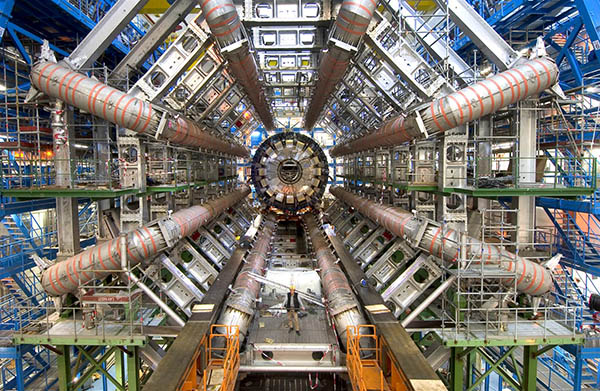
Image by CERN
The Large Hadron Collider (LHC) is the world's largest and most powerful particle collider, built by the European Organization for Nuclear Research (CERN) from 1998 to 2008. Its aim is to allow physicists to test the predictions of different theories of particle physics and high-energy physics, and particularly prove or disprove the existence of the theorized Higgs particle and of the large family of new particles predicted by supersymmetric theories. The Higgs particle was confirmed by data from the LHC in 2013. The LHC is expected to address some of the unsolved questions of physics, advancing human understanding of physical laws. It contains seven detectors, each designed for certain kinds of research.
The LHC was built in collaboration with over 10,000 scientists and engineers from over 100 countries, as well as hundreds of universities and laboratories. It lies in a tunnel 27 kilometers (17 mi) in circumference, as deep as 175 metres (574 ft) beneath the Franco-Swiss border near Geneva, Switzerland [text from Wikipedia].
The principle that this device operates on is that its movement is located on the infinity ring. This is the location within the transformation sequence where the vortex movement is the slowest, nearing zero velocity. Time almost comes to a standstill in the path of this huge subterranean ring shaped vortex. But as every meter of this large-scale vortex comes to an almost complete standstill, at that same time everything on a small-scale reacts by doing the opposite, by speeding up to a very high velocity.
An action on a mesocyclic scale induces an opposite reaction on a microcyclic scale. A decrease in velocity on a mesocyclic scale results in an increase in velocity on a microcyclic scale. The many particles, which are microscopic vortices, accelerate to very high velocities because they reside within the single larger vortex as residential particles. That larger vortex has almost no velocity. Time appears to almost stand still on the greater mesocyclic scale.
A larger particle accelerator is more effective in speeding up the microscopic particles, because larger scale sizes are higher dimensional. And higher dimensional means slower movement. Thus the larger the circular device, the lower the velocity of the large circular vortex, and the higher the velocity of the microscopic vortices.
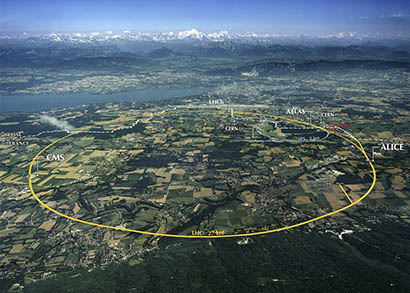 Image by CERN |
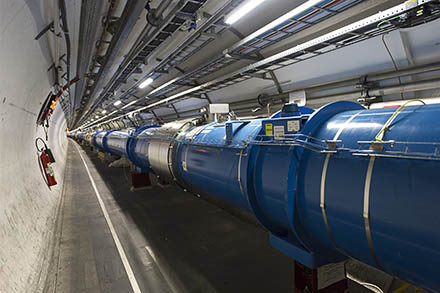 Image by CERN |
What lies exactly on this ring is the equivalent of electricity. Or better said, an electric current. Yet this large vortex is not identified / measured as electricity. The reason for that is again its size. Would this device be much smaller, so small that we could hold it in our hands, then the vortex would be identified / measured as electricity. Because it is much larger we humans fail to comprehend in its observations that this device does the same thing as creating an electric current, yet on a different scale size, and within a different medium. Electric currents usually are made to flow through metal wires, which induce a vortex flow of much smaller scale size. This electric current of the accelerator is made to flow through a vacuum. Both metals and vacuums are substances that we find in the third half-cycle (vacuums are never complete vacuums, so therefore they're substances as well). Because of these differences we can not measure the force within the accelerator in the same way as we measure an electric force in a wire, but most of its vortex characteristics are still the same.
One other thing I would like to add here is that the sub-atomic particles are not traveling in a full circle for miles. The sub-atomic particles are not even traveling one meter. The particles that are detected at one location within the circle of the accelerator are not the exact same particles that are later detected at another location in the accelerator. The particles are moving faster and faster but they remain stationary within the location that we humans can see with our eyes, only at the very small scale level they move around, and some of this movement is only vibrational. The reason that they appear to move around is that they are constantly being created and annihilated by the mesocyclic scale vortex movement. The large mesocyclic scale vortex makes a flow movement to which the particles at the microcyclic scale counter-react. The condition at the mesocyclic scale determines in what number and in what type the particles at the microcyclic scale are made to exist. The collision in the particle accelerator takes place at the mesocyclic level, not the microcyclic level.
Hyperkone
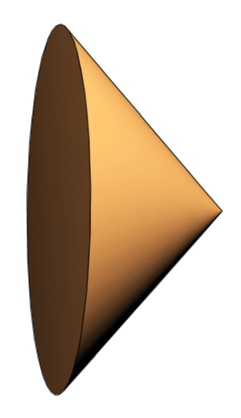
| Classification | Half a spiral of the second cycle |
| Dimension | 0.0D to 0.25D (dimension level zero) |
| Positive / Negative | Positive |
| Core | Yes |
| Periphery | Unknown |
| Rotational sum movement | Yes |
| Minimum number of movements | Near zero |
| States of equilibrium |
Inorganic: Diamond Organic: Unknown |
| Origin of the name | Hyper because of its link to high velocities, as in hyper-speed. Kone because of its cone shape. I wanted to name this vortex the hypercone but that name already belongs to a mathematical object |
The hyperkone (pronounced as 'hypercone') looks like a steep cone, unlike the spire, which looks like a sharp cone. While the spire is a movement in a straight line without a rotation, the hyperkone is a rotation with perhaps no movement along an axis. This is uncertain at the moment. It could also be that it has both.
Like the other spirals, this can also be a double spiral, because it too can have two arms, which in this case do no longer look like arms. And the spiral, either a single or a double can connect with a bridge to form a binary spiral. It is not certain however that the drawing of the binary hyperkone shows its correct shape. The vortex does exist, but the vortex between the two spirals might be an exterior tunnel instead of an outer bridge.
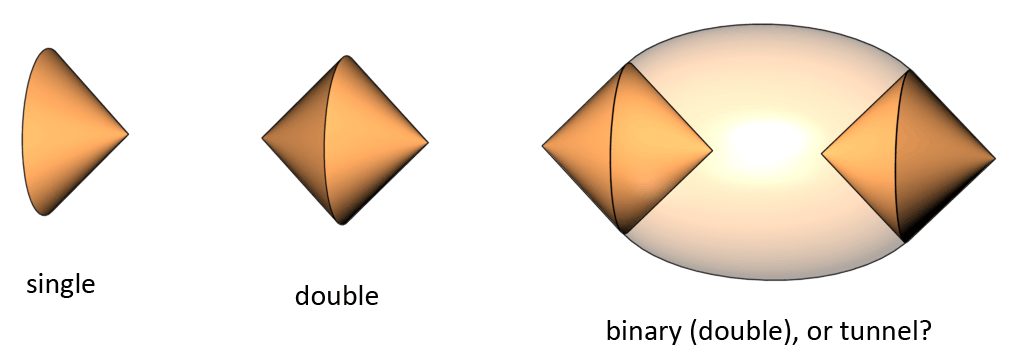
The rotation in this vortex is revealed by how bullets fly through the air. Modern rifles have a set of grooves inside the barrel that are curved. These grooves makes the bullet spin as it flies. This makes the bullet fly 10 times farther and more accurate, within a straight line. The cone can be considered to be the tip of the bullet.
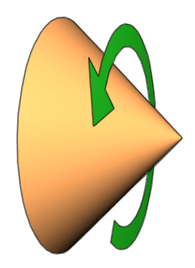
The animation below shows the position of the hyperkone in a connected sequence. It is not sure if the tips of two opposing hyperkones do actually touch. There might always be a space in between the two tips of the cones.
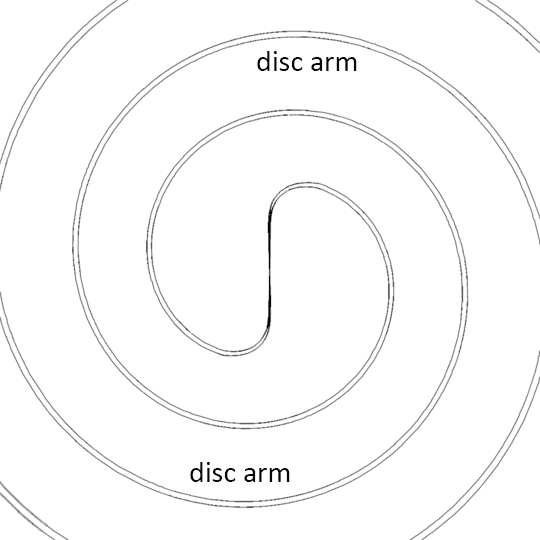
The existence of this cone itself is revealed by at least two important clues. First is that a rocket should be regarded to be one of the closest man-made aerodynamic objects that resembles the shape of a spire. But a rocket does not have a sharp tip, instead most rocket designs end with a steep cone at the tip. This at least is suspicious, and here we could start to suspect that the spire is not the lowest dimensional vortex within the first forward half cycle, but that there could be another vortex (or in this case, partial vortex) before the absolute zero point is reached.
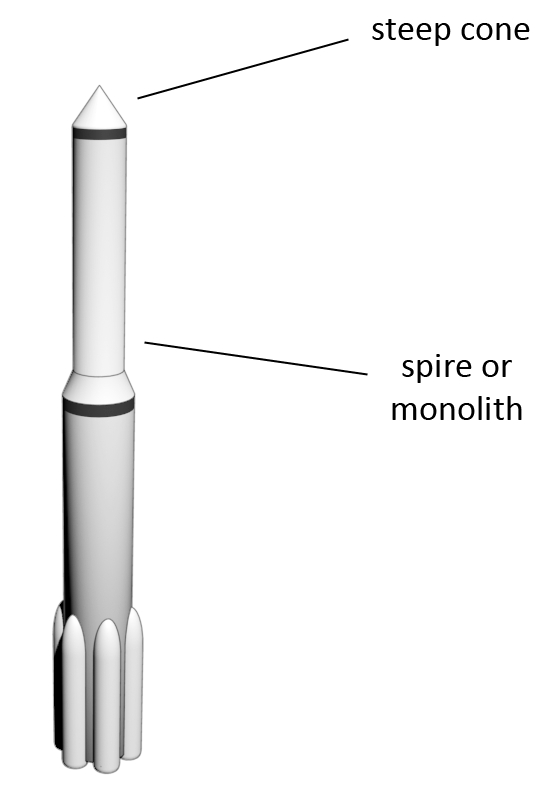
The second clue are disc spirals found in silicon. These spirals sometimes show a trapezoidal structure, thus are no longer flat are somewhat conical, but still very steep. This is because these spirals are lowmorph disc spirals. They are partially morphed into hyperkones, which is a subsequent vortex in the morph sequence.
And yet another possible clue is the shape of the shock waves that appear when an object moves faster than the speed of sound. The photograph below shows a NASA photo of an X-15 model in a supersonic wind tunnel, and the +45 degree angle of the shock wave cone starting off at the tip of the aircraft. Interestingly, the cone gets steeper as the plane increases its speed. This cone could be an indication that a steeper cone is the best aerodynamic front shape of a body when an object moves at high velocity. The X-15 model shown in the image below has a conical tip which is much less steeper, yet the shock waves takes on the steeper form.
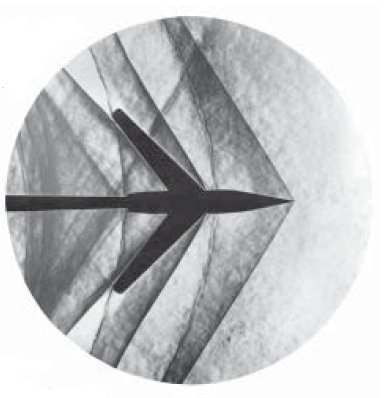
Keep in mind that the actual vapor cloud that suddenly appears when air aircraft surpasses the speed of sound is not a hyperkone. It does however have the same steepness and looks somewhat similar. But its motion is perpendicular to that of this cone spiral.
The hyperkone could be a partially missing link in aerodynamics. Rockets have this cone at the top, but without a rotation. Bullets have the rotation, but rotating a rocket at great speed like a bullet is simply not a possibility. But because a rocket is a spire, and does not need to rotate, the cone on top of that rocket can be made to rotate. This could reduce air resistance when traveling at great speeds. And it could perhaps prevent a sonic boom from happening for both rockets and airplanes, even when the speed of sound is exceeded.
Shock Diamonds
The shape of the binary form of the cone is also revealed by something closely related to shock waves. Namely the shock diamonds sometimes seen in rocket exhausts. These are a formation of standing wave patterns that appears in the supersonic exhaust plume of an aerospace propulsion system, such as a supersonic jet engine, rocket, ramjet, or scramjet, when it is operated in an atmosphere. The diamonds are visible due to the ignition of excess fuel. Mach diamonds are named for Ernst Mach, the physicist who first described them.

Image by Swiss Propulsion laboratory
It is not sure if these binary cones are connected with normal outer bridges or if they are connected with S-bridges (in fact, it could also be an exterior tunnel instead). Both can connect spirals in a repeating pattern. It is not certain how the outer bridges and S-bridges differ in shape for this particular vortex type, but the shape could be somewhat similar.
These hyperkones are formed by plasma, but they're also lowmorph hyperkones. This you can see by its slightly inward curvature of the cones. The cones are slightly morphed into amplipoles, which are negative dimensional vortices. This could explain why they're made of plasma despite that the vortices are positive dimensional. This vortex lies very close to the zero point EM crossing location, any descending of the vortex will rapidly make it enter the negative dimensions.
Very Strong Tornadoes
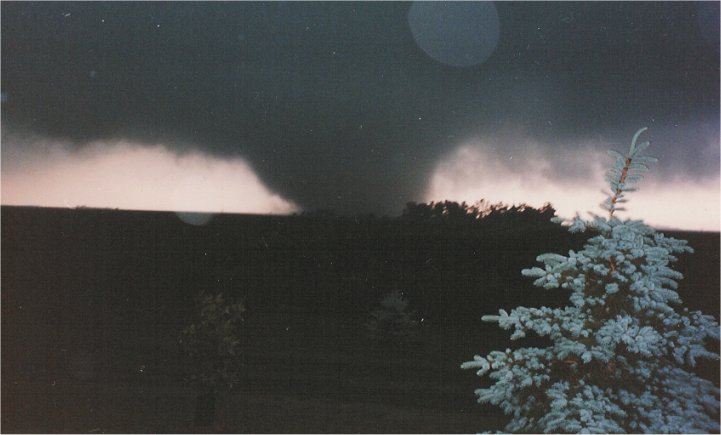 Image by Gary Baker for US National Weather Service |
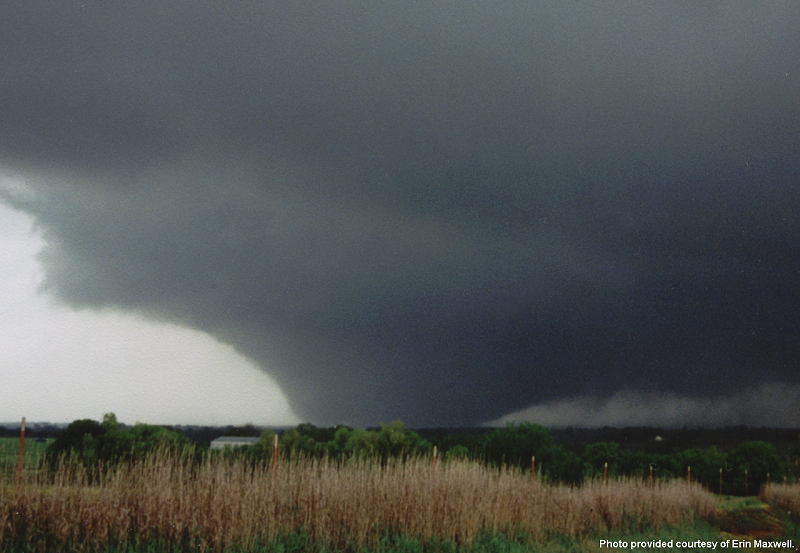 Image by Erin.D.Maxwell for US National Weather Service |
The strongest types of tornadoes, from somewhere around category F3 to F5 are most often formed by a hyperkone vortex. These types of tornadoes are the widest and its rotation is very evident. Tornadoes that are shaped by amplicones can sometimes be quite wide as well, but with those tornadoes the rotations is much slower and hardly noticeable at all because the meridians of an amplicone rotate in both opposite directions. The hyperkone only rotates in one direction horizontally.
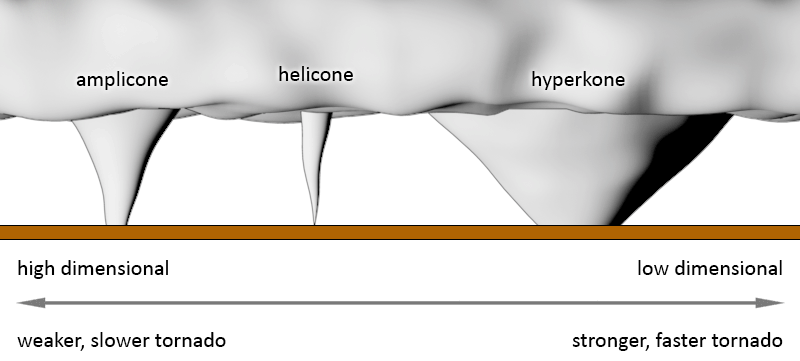
I haven't been able to determine with certainty what exactly the morph sequence is for all types of tornadoes. A helicone can morph into an amplicone, and it is not likely that a hyperkone can morph into a helicone. In some observations it seems that tornadoes can morph into lower dimensional tornado types, if that would turn out to be true than morphing can happen in two directions instead of only one. This still needs more investigation.
One inconsistency with the theory is that the strongest tornadoes, like the F5 tornadoes, are also the largest tornadoes. I had expected that it would be the opposite, the hyperkone should be the smallest vortex while the amplicone should be the largest. I still have no explanation for this.
Amberon
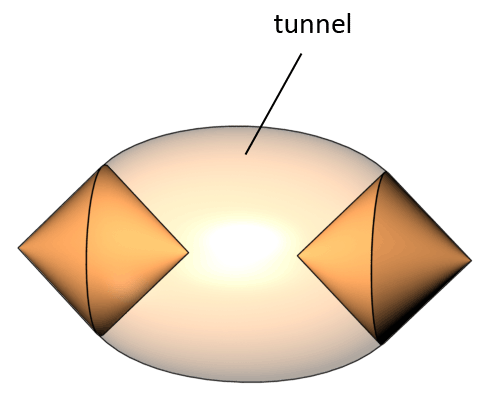
| Classification | First tunnel or first outer bridge of the first cycle |
| Dimension | ~0.0D |
| Positive / Negative | Positive |
| Core | Yes |
| Periphery | Unknown |
| Rotational sum movement | Unknown |
| Minimum number of movements | Near zero |
| States of equilibrium |
Inorganic: Glass (if tunnel), Amber (if outer bridge) Organic: Unknown |
| Origin of the name | It is named amberon because its state of equilibrium is perhaps the mineral amber (this needs to be changed if proven wrong) |
The amberon is a vortex that connects two hypercone spirals, and it is not sure if this connection is an exterior tunnel vortex or an outer bridge. When looking at the morph sequence and how the helix tunnel morphs into this vortex, then it's appears that this vortex is a tunnel. Yet when looking at how this vortex can appear in a repeating pattern, by connectings numerous amberons in a row, then it seems that this vortex is an outer bridge, or an S-bridge. The only good example of this vortex are the shape of an engine exhaust when shock diamonds form. If it turns out that this vortex is a tunnel then I might change the name of this vortex later, because the name amberon refers to the state of equilibrium of the first outer bridge.
The exact dimension level of this vortex is unknown. It is somewhere between 0.0D and 0.25D, thus somewhere without the range of the dimensionality of the hyperkone. If the morph sequence determines the dimension level of this vortex than it must be 0.0, but if that would be the case then I would expect this vortex to emit more light than it does. The next tunnel in the sequence, the photosphere, emits much more light than this vortex does, and that vortex should be somewhere close at 0.0 as well.
The video above shows the shock diamonds of a methane rocket engine. Both the hyperkones and the amberons are clearly visible. As you can see, these vortices repeat themselves. Therefore it is quite possible that the amberon is an s-bridge, a variation of an outer bridge (the s-bridge is introduced on the page titled 'more about vortices'.
Conic Inlets
Image by Rosario van Tulpe
The nose-tip of many types of aircraft is more or less shaped like a hyperkone because in that way it induces the aerodynamic effect of a hyperkone vortex, which makes it more suitable to travel at great speeds. The above image shows a MIG-21 Fighter Jet, which is somewhat more interesting to mention here than most other aircrafts with conic tips, because unlike those, which only use the shape of a single hyperkone, this aircraft uses the shape of a binary hyperkone. The cone is located at the tip of the aircraft while the air that flows into the aircraft at the nose forms the amberon that connects to the hyperkone.
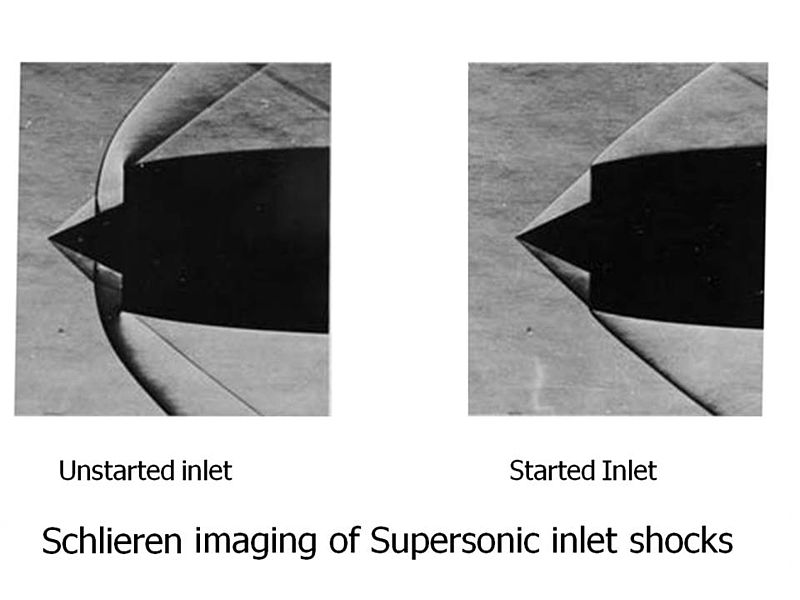
The two images above, made by NASA Glenn Research Center, show how the air around the inlet flows. Without the use of the inlet the air around the nose bends into a higher dimensional vortex, thus a slower vortex movement. With the use of the inlet the air around the nose makes a sharper angle and forms a lower dimensional vortex, thus allows a faster vortex movement.
Light

| Classification | Intermediate spiral |
| Dimension | 0.0D or close to 0.0D (dimension level zero) |
| Positive / Negative | None |
| Core | Yes |
| Periphery | No |
| Rotational sum movement | No |
| Minimum number of movements | 0 |
| States of equilibrium |
Inorganic: Unknown Organic: Unknown |
| Origin of the name | Light because this vortex is light. But if it turns out that this vortex also manifests itself in different forms (like natrolite and mesolite shown further below suggests) then the name might need to be changed |
Its not that easy to decide how to make a drawing that shows how light as a vortex look like. Basically it is a vortex that is stretched out in all directions from a single point source, with the intensity increases as one approaches the source. Although light behaves like a spiral, it doesn't directly show a rotation. Light is considered to be a non-rotational vortex.
Light is both a vortex and a wave. Or to say it more correctly: the vortex is the wave. It is a special case in the projection of waves from the onefield onto our three-dimensional world where the angle of projection is exactly zero and the entire wave is located within our physical world. This sets light apart from the other vortices in the sequence by its observed characteristics. Light is visible, can be blocked by physical objects, and expands linear outward in all directions.
Natrolite and Mesolite
The shapes of some minerals are formed by the same movement of light. This is because light is a vortex, a vortex that is close to the spire in the sequence. The state of equilibrium for crystals is the spire, the characteristics of crystal are controlled by the movement of the spire (this will be explained on the page about state of equilibrium). Because light is a vortex that is close in dimensionality to the dimensionality of a spire, it is also understandable that the movement of light can also be identified within the shape of some crystals.
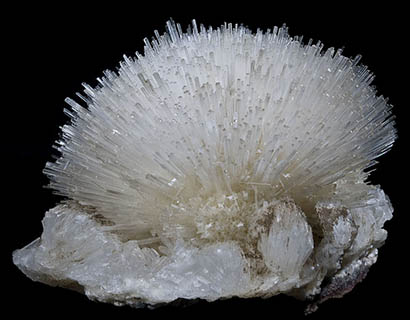 Natrolite. Image by Didier Descouens, under CC BY-SA 4.0 license |
_UnderCCBYSA3.0.jpg) Mesolite. Image by Photolitherland (Wikimedia), under CC BY-SA 3.0 license |
The photos above show two such crystals formed by minerals. One is Natrolite, the other is Mesolite. Both minerals can form complete spheres that grow out equally in all directions. This is the same shape of movement, formed by the same vortex as light. The same shape and movement sometimes appears within (semi-) transparent crystals when hit by an external force, for example a metal pin. Glass or ice can be damaged in such a way that these white stars appear within the crystal's volume, which looks closely similar in shape to the mineral crystals in the photos above.
Quasars
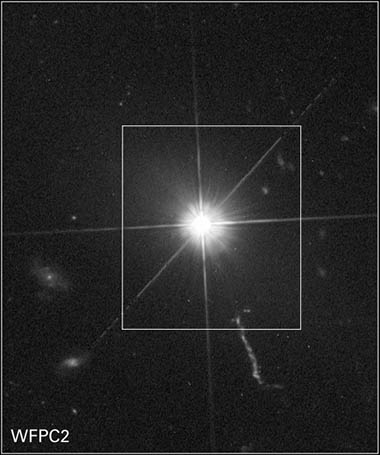
Image by NASA
Quasars are extremely luminous point sources of light in the center of a massive galaxies. Their luminosity can be 100 times greater than that of the Milky Way.
There's a good possibility that a quasar is formed by the same vortices that emit the light from a star, with the difference that with a quasar, there is no vortex present like the photosphere that is present around a star. The photosphere is a bridge vortex, with quasars there is no bridge vortex because the light, which is a spiral, is a single or double spiral, not a binary spiral with a bridge. The photosphere encapsulates the spiral and thereby blocks some of the light emitted from the spiral. Quasars are what the astronomers describe them, they are point lights, with no body at the center, with no spherical vortices present around that central point light.
QUASAR = SINGLE OR DOUBLE EM SPIRAL, NOT A BINARY
Amplipole
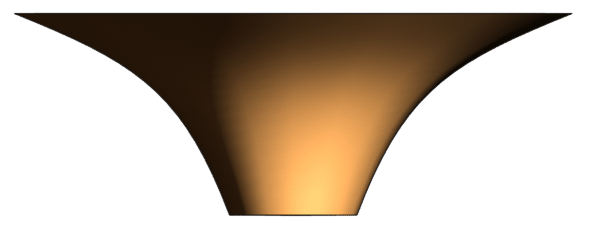
| Classification | Half a spiral of the first cycle |
| Dimension | -0.25D to 0.0D (dimension level zero) |
| Positive / Negative | Negative |
| Core | Yes |
| Periphery | Unknown |
| Rotational sum movement | No |
| Minimum number of movements | Near zero |
| States of equilibrium |
Inorganic: Unknown Organic: Unknown |
| Origin of the name | Ampli from amplify, refering to its progressive increase in width along its axis. Pole because two of these vortices connect to the two poles of the sun, forming the poles of the sun's corona |
The sun's corona does not consist of one vortex type, but two. One vortex type forms the poles of the corona, which extent from the sun at opposite sides and has a regular shape. The other vortex type is the remaining part of the corona, which extents from all the way around the circumference of the sun outwards and has a more chaotic shape.
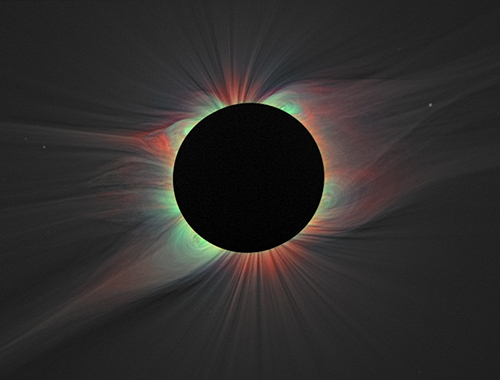
Image by Habbal / NASA, under CC BY 2.0 license
The photo above shows the poles of the corona quite clearly. The poles extent from the north and south side of the sphere outward. I do not know if the vortex starts all the way at the center of the sun, or that it starts at the outer edge of the sun, or something in between. The sun is not the only known observation of this type of vortex. The amplipole is also found in the mesocyclic scale level in a type of fire called a blue whirl and in some variations of shock diamonds. In the case of the sun, the two non-rotational vortices form the poles of the corona, and they also look to some extent like amplicones, for these two reasons they are named amplipoles.
The first half of a EM transition vortex can morph into its second half. Thus the EM transition vortex that is located at the upper side of the zero point can morph into the near-EM spiral that is located at the lower side of the zero point. The hyperkones can morph into the poles of the corona. When a binary hyperkone morphs towards the next half of the EM transition vortex, the result are two amplipoles with a photosphere.
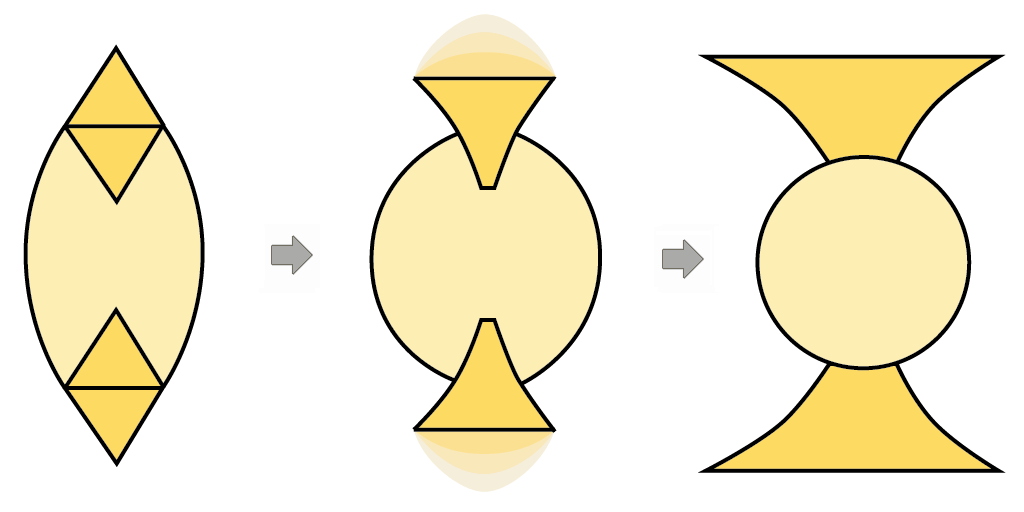
I'm also not sure if the two amplipoles are two different vortices (of the same type), it could be that those two vortices are one vortex, one that is a merging of two different spirals when morphing from hyperkone to amplipole. This could be a possibility because there are more vortices that combine into one when morphing.
A Blue Whirl
Scientists from the University of Maryland discovered a previously unobserved type of flame which they published in an online paper on August 4, 2016, in the peer-reviewed journal Proceedings of the National Academy of Sciences. They initially set out to investigate the combustion and burning dynamics of fire whirls on water. What they discovered was a novel, swirling blue flame that they say could help meet the growing worldwide demand for high-efficiency, low-emission combustion.
The lower part of this flame looks very much like an amplipole, with the only difference that its shape is hollow, the amplipole most likely is not. This could thus be an amplipole or a vortex type that is closely related to the amplipole, one of the same dimensionality level but one cycle lower instead. The upper regions of the vortex, which are the belt-like vortex at the top of the cone and the convolute-like vortex above that, are different vortex types which are not yet identified. A convolute vortex is a type of s-bridge that connects two revolute spirals that are both right turning or both left turning. Such a vortex can connect to a laminar belt, but there are no spiral windings visible in the image. The flow direction of is also likely to be opposite to the normal flow direction of the convolute.
Photosphere

| Classification | First tunnel of the first lower cycle |
| Dimension | ~0.0D |
| Positive / Negative | Negative |
| Core | Yes |
| Periphery | Unknown |
| Rotational sum movement | No |
| Minimum number of movements | Near zero |
| States of equilibrium |
Inorganic: Unknown Organic: Unknown |
| Origin of the name | It is named photoshpere because this vortex forms the photophere of our sun |
The photosphere is the tunnel vortex that connects two amplipoles. The exact dimension level of this vortex is unknown. It is somewhere between 0.0D and -0.25D, thus somewhere within the range of the dimensionality of the amplipoles. If the morph sequence determines the dimension level of this vortex than it must be -0.25D. If the distance to the EM spectrum should be identical to the distance to the EM spectrum of its antipode (the hyperkone), then the dimensionality should be somewhere close to 0.0D. Because this vortex emits so much light, I suspect that its dimensionality is close to 0.0D. The photosphere is a non-rotational vortex.
The name of this vortex comes from the sun's photosphere, which is the only known observation of this type of tunnel vortex. The photosphere is the outer most layer of the sun. It is one of the largest layers of the sun, yet its volume is one of the lowest. The deeper, more voluminous layers of the sun are vortices further down in the negative dimensions.
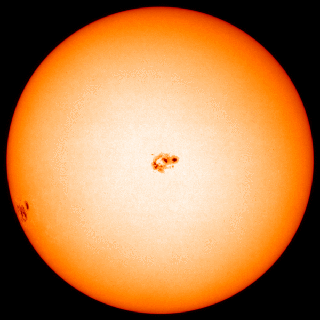 |
I'm not sure if this vortex has a periphery. Judging from its distance to the Em spectrum I would expect this vortex to form no physical matter. But the sun's photosphere is a physical object. It could be that the sun's photosphere is a highmorph vortex, or a dilated vortex.
More about this vortex will be said on the page about the negative dimensions.
Electricity

| Classification | Intermediate spiral |
| Dimension | 6.0D (eleventh dimension level) |
| Positive / Negative | None |
| Core | Yes |
| Periphery | No |
| Rotational sum movement | Yes |
| Minimum number of movements | Unknown |
| States of equilibrium |
Inorganic: Unknown Organic: Unknown |
| Origin of the name | It is named electricity because that is what it is. A more specific description is 'electric current' |
Electricity is a circular vortex that does not have volume, although in most situations you will not find this vortex in the shape of a circle. The vortex is located at exactly 6.0D within the transformation sequence, which is the position on the EM spectrum line called the infinity ring. Here, the angle of projection is exactly perpendicular to our physical world. Because of this an electric current is a physical vortex without volume, and without in or outgoing waves.
Note that in the image above, I drew the vortex as a dashed line. This is only to indicate that the vortex itself is not visible, not to indicate that the movement is interrupted along the path. Like any other EM vortex, this vortex does not have volume. Electricity is a rotational vortex.
Some electric discharges produce circular arcs. It could be, yet it's not certain, that these circular arcs are circular because the vortex movement is close to, or even reaching, the infinity ring. The video below shows one such possible observation.
The visible circular arc can not be the electric current itself, because the electric current does not have volume. If there is a relation between this electric arc and the infinity ring, then it is probable that the electric arc is vortex close to the infinity ring, thus close to an electric current but not quite the same. Atmospheric lightning can be circular as well, although this is extremely rare, and here too the exact type of the vortex is uncertain.

Photo taken during Chicago February 1, 2011 blizzard,
photographer unknown
Electric currents that are made to flow through a wire are seldom circular. This is possible for such a vortex because electricity is a very high dimensional vortex, it has many meridians. The arc can bend into many shapes, and does not even need to be a full closed circle. This same characteristic is shown by other high dimensional vortices within the first half-cycle. Although the vortices do no need to be circular, they still prefer to be circular. There is a possibility that an electric current prefers to be circular as well.
Most movement close to the zero point never reaches the zero point. So too does most movement close to the infinity ring never reach the infinity ring. If both these rules would be different then we would see flashes of light when objects travel at very great velocities, and we would experience a possible electric shock when touching a smoke ring. In both situations this is not so.
Electricity is induced by the movement of a spiral, therefore it is also likely that electricity can exist in the form of a left-turning spiral, a right-turning spiral, or a binary spiral. Electricity in the form of a right-turning spiral is what is known as a positive charge. Electricity in the form of a left-turning spiral is what is known as a negative charge. I am not going to explain on this page how that relation was determined, the explanation as to why it is known that a positive charge is a spiral turning in one direction and a negative charge is a spiral turning in the opposite direction is explained on the page about state of equilibrium.
|
|
_UnderCCBySA3.0.png) Equivalent of left turning spiral |
_UnderCCBySA3.0.png) Equivalent of a binary spiral |
Logically, there is also electricity in the form of a binary spiral, which is an electric current between a positive charge and a negative charge. The outer bridge from of the binary spiral combined with a tunnel vortex between those same two spirals forms an electric field around those two poles (the two spirals).
NEGATIVE AND POSITIVE CHARGE ARE THE SPIRAL'S LEFT AND RIGHT TURNING MOVEMENT
THE ELECTRIC FIELD GENERATED BY A CIRCULAR CURRENT IS A TUNNEL + OUTER BRIDGE COMBINATION THAT CONNECTS THE TWO SPIRALS
Sinusoid Deformation of vortices close to an EM crossing location
Sometimes, when a vortex within the third half-cycle or possibly higher is morphing sequentially towards the higher dimensions, the shape of the vortex takes on the form of a sinus wave. If the vortex then morphs further upward it becomes unstable and falls apart. I do not knows what causes this. I've tried to look in different directions for an explanation for this phenomenon but in none of those scenarios the puzzles fit.
The phenomenon does appear to happen with a scroll ring, but not with a tubular ring. Yet it is possible for a mirage also to show this sinusoidal shape. This deformation appears in both the first and the second cycle. The shape of this sinusoidal wave does not appear to be a logical shape that fits with the other vortices close to the EM spectrum if connected in a sequence.
So I do not know the cause, yet for now I decided to call it the sinusoid deformation. Two examples of this sinusoid deformation are illustrated below.
sinusoid deformation of a scroll ring

sinusoid deformation of a mirage

Smoke Rings

This is what is what often happens when a vortex ring is traveling through the air. As it travels, the vortex ring becomes larger and thinner, until at some point (but not always), the ring bends into a sinus wave pattern, shortly before it becomes unstable and falls apart.
Yoke Nuclear Test

This occurrence of a sinusoid deformation happened at the Yoke nuclear test, which was carried out on the 1st of may 1948 on Island Aomon, Enewetak Atoll, and is as far as I know the only occurrence of a sinusoid deformation of this kind at a nuclear detonation. The explosion formed a large condensation cloud with sinusoidal edges.
| All content on this site that is authored by Peter.A.Venis is licensed under the Creative Commons CC BY 4.0 license, unless otherwise mentioned. Most pages on this website also include material from other authors, under different licenses. Both the author's names and the licenses are mentioned in the file names whenever this information is known and can be provided. The presence of work from other authors on this website does not necessarily imply that those authors endorse the contents of this website. |
| A word that is often used on this website is the word 'vortex'. Many sources describe a vortex as a movement in a fluid that has a rotational flow. Yet many of the vortices that I describe on this website do not show a visible rotational flow. I took the liberty of using the word vortex for describing a phenomenon that had not been understood before, one that links together rotational and non-rotational movements. Even a movement in a straight line can in some cases be categorized as a vortex, if it is known that that movement is created by certain identical conditions. So keep in mind that the word 'vortex', within the context of the infinity-theory, has not the exact same meaning as other sources describe. |




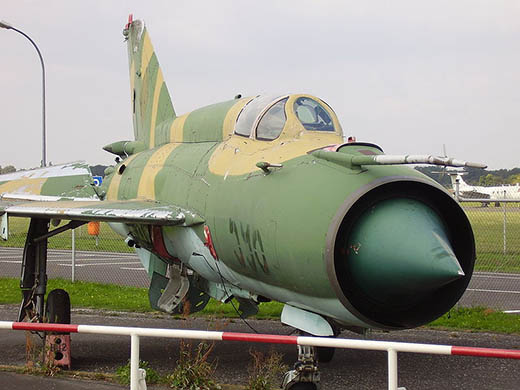
_UnderCCBySA3.0.png)